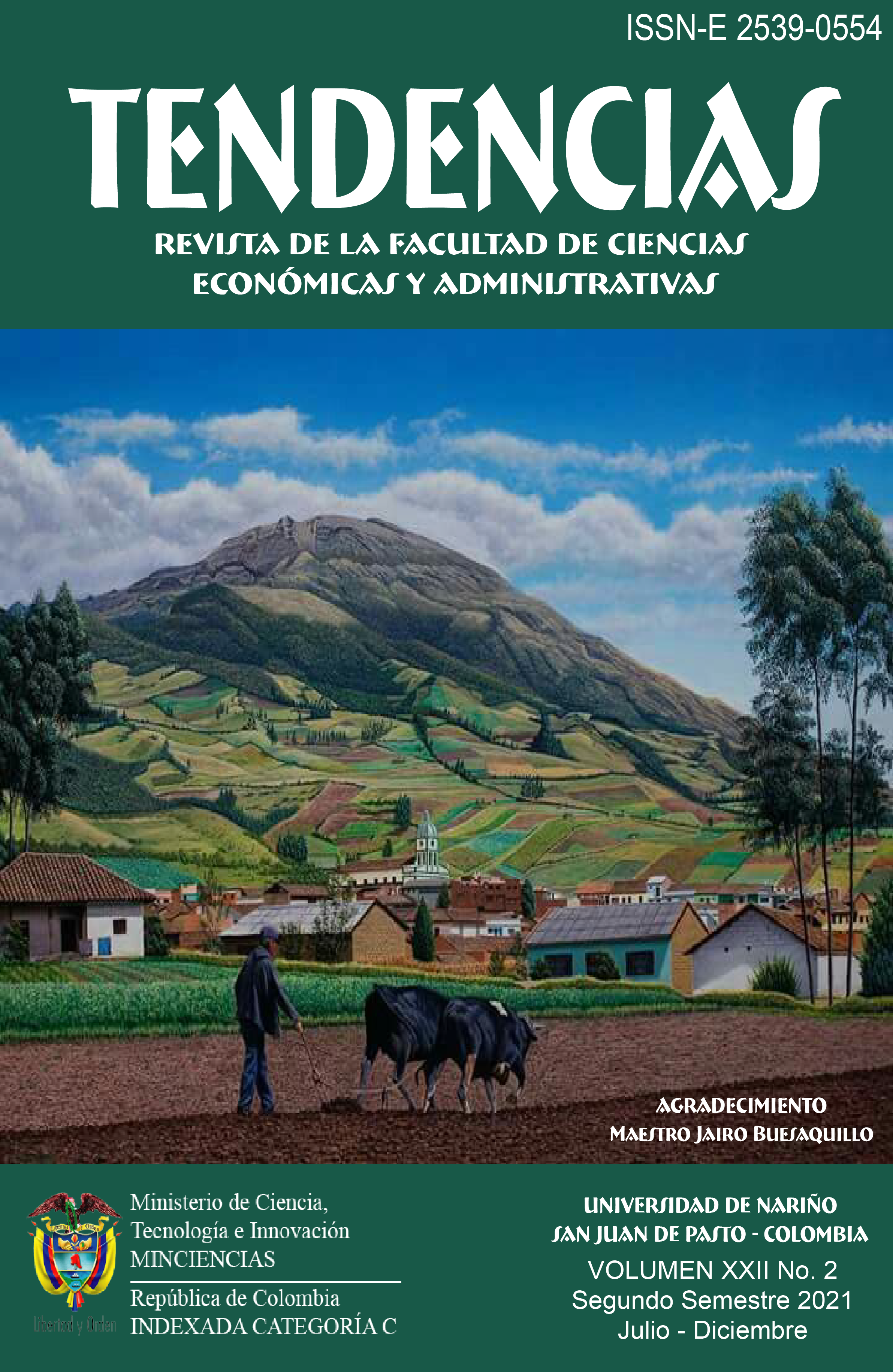The experience of the use of money in low-income people in Bogotá, november 2019
DOI:
https://doi.org/10.22267/rtend.212202.172Keywords:
banking, low-income people, financial education, financial inclusionAbstract
This article explores the experience of the use of money in low-income people in Bogota, understanding the levels of banking that this population has and the importance of financial education in the role of the economy and the market. In Colombia, few institutions and studies have reviewed the experience of money use and its relationship to banking and financial inclusion, especially among low-income people. Therefore, this article explores the following conjecture: until there is a judicious inquiry that qualitatively describes the motivations and contexts of low-income people in their daily realities and needs in the face of the supply of financial products and services, there will be no adequate information and sufficient to enable government and private financial sector entities to build effective and relevant strategies to effectively bankrupt this population. Through in-depth interviews, these motivations and decisions are explored, demonstrating with this research that adequate financial education from childhood, as well as financial inclusion policies appropriate to this type of population based on a thorough knowledge of their daily actions, context and lifestyle will lead to the implementation of better strategies.
Downloads
References
(1) Alcaldía Mayor de Bogotá. (2018). Atlas Económico 2017. http://observatorio.desarrolloeconomico.gov.co/sites/default/files/files_articles/atlasfinweb.pdf
(2) Arango-Arango, C. A., Suárez-Ariza, N. F. y Garrido-Mejía, S. H. (2017). ¿Cómo pagan los colombianos y por qué? Borradores de Economía, (991). http://www.banrep.gov.co/docum/Lectura_finanzas/pdf/be_991.pdf
(3) Asociación Bancaria y de Entidades Financieras de Colombia [Asobancaria]. (2016). Experiencias y aprendizajes de la educación financiera. https://www.sabermassermas.com/wp-content/uploads/2016/08/Cartilla-Educacion-Financiera-Asobancaria-Mayo-Sin-lineas-de-Impresion.pdf
(4) Asociación Bancaria y de Entidades Financieras de Colombia [Asobancaria]. (2018). ¿Por qué debemos implementar el programa de Educación Financiera en los colegios de Colombia? Semana económica, 1167. https://www.asobancaria.com/wp-content/uploads/1167.pdf
(5) Banca de las Oportunidades. (2018). Principales hallazgos
del Estudio de demanda de inclusión financiera. Segunda toma. http://bancadelasoportunidades.gov.co/sites/default/files/2018-08/Presentaci%C3%B3n%20Estudio%20de%20demanda_0.pdf
(6) Bankia. (2018, 3 de octubre). Países en los que el efectivo está a punto de pasar a la historia. https://www.blogbankia.es/es/blog/paises-sin-efectivo.html
(7) Castellanos, D. y Díaz, C. (2012). La banca en 2012. Semana económica, 882. https://www.asobancaria.com/semanseconomicas/Sem_882.pdf
(8) Castro, S. (Ed.). (2017). Proyecto F. Diagnóstico del uso del efectivo en Colombia. Asobancaria. https://www.asobancaria.com/wp-content/uploads/2017/12/Proyecto-F.pdf
(9) Comisión Intersectorial para la Educación Económica y Financiera [CIEEF]. (2017). Estrategia nacional de educación económica y financiera de Colombia (ENEEF).
(10) Departamento Administrativo Nacional de Estadística [DANE]. (s.f.). Glosario Índice de Precios al Consumidor -IPC-. www.dane.gov.co/index.php/estadisticas-por-tema/precios-y-costos/indice-de-precios-al-consumidor-ipc/glosario-ipc
(11) Dinero. (2019). ¿Qué países de América Latina pasan más las tarjetas? Revista Dinero. https://www.dinero.com/internacional/articulo/en-que-paises-de-america-latina-se-paga-mas-con-tarjetas/268363
(12) McLeay, M., Radia, A., & Thomas, R. (2015). El dinero en la economía moderna: una introducción. Revista de Economía Institucional, 17(33), 333-353. https://doi.org/10.18601/01245996.v17n33.15
(13) Organización para la Cooperación y el Desarrollo Económico [OCDE]. (2005). Improving financial literacy: Analysis of issues and policies. https://www.oecd.org/daf/fin/financial-education/improvingfinancialliteracyanalysisofissuesandpolicies.htm
(14) Organización para la Cooperación y el Desarrollo Económico [OCDE]. (2012). Apertura de la 9.ª Conferencia de Educación Financiera “Próximos retos: de las políticas a las prácticas eficientes”. https://www.oecd.org/daf/fin/financial-education/50347719.pdf
(15) Pablo, T. (2013). Bancarización en América Latina. Expansión.com. http://www.expansion.com/2013/07/23/latinoamerica/economia/1374567449.html
(16) Palacios, Á. E. (2016). La heterogeneidad de los trabajos informales [Tesis de maestría, Universidad EAFIT]. http://www.eafit.edu.co/programas-academicos/posgrado/maestria-administracion-financiera/investigacion/Documents/confianza%20e%20inclusi%C3%B3n%20financiera%20en%20Colombia.pdf
(17) Reddy, R., Bruhn, M. y Tan, C. (2013). Capacidades financieras en Colombia: resultados de la encuesta nacional sobre comportamientos, actitudes y conocimientos financieros. Banco Mundial. http://www.bancomundial.org/content/dam/Worldbank/document/LAC/Capacidades%20Financieras%20en%20Colombia.pdf
(18) Severino, J. (2017). Inclusión financiera difiere del concepto de bancarización. El Dinero. https://www.eldinero.com.do/49461/inclusion-financiera-difiere-del-concepto-de-bancarizar/
(19) Tafur, C. (2009). Bancarización: una aproximación al caso colombiano a la luz de América Latina. Estudios Gerenciales, 25(110), 13-37. https://doi.org/10.1016/S0123-5923(09)70060-9
(20) Vera, A., Zuluaga, A. M., Ríos, A., y Clavijo, S. (2019). Reducción del efectivo y tamaño de la economía subterránea en Colombia. Asociación Nacional de Instituciones Financieras, ANIF, Biblioteca virtual. http://www.anif.co/Biblioteca/entrevistas/reduccion-del-efectivo-y-tamano-de-la-economia-subterranea-en-colombia
Published
How to Cite
Issue
Section
License
Those authors who have publications with this journal, accept the following terms:
This journal is licensed under a Creative Commons Reconocimiento-NoComercial 4.0 Internacional License. The articles can be copied, distributed, adapted and communicated publicly, as long as the credits of the work are recognized and the respective source is quoted. This work can not be used for commercial purposes.
To increase their visibility, documents are sent to databases and indexing systems.
The content of the items is the responsibility of each author, and does not compromise in any way, journal or institution.







































